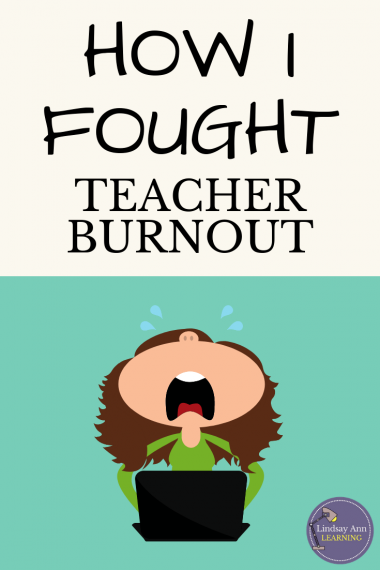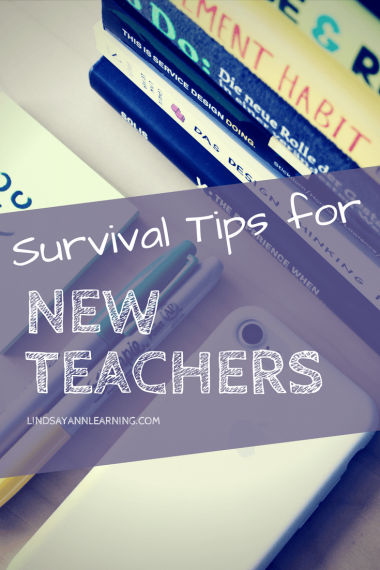Teacher burnout. The struggle is real.
I have written and deleted this introduction at least 10 times. Why? Because it just sounds so cliché. I mean, if you’re a teacher, you’ve heard, thought, lived, breathed the causes of teacher burnout.

Do I really need to state what we all know?
We all know that most teachers who are still in the profession have at least thought about leaving due to lack of in-school supports, increasing behavior issues, large class sizes, unmotivated students, lack of parental support, initiative fatigue, pressure from administration, lack of autonomy and authority, no “real” consequences for student behavior…and the list goes on.
Maybe song lyrics can capture teacher stress…
Every little thing [we] do / Never seems enough for [administration, parents, students, community members] -N’Sync
[We] need somebody (Help) – Beatles
S-O-S, please, someone help me / It’s not healthy for me to feel this / Y-O-U are making this hard / You got me tossing and turning, can’t sleep at night -Rihanna
Why am I obsessing / About the things I can’t control? / Why am I seeking approval / From people I don’t even know?
They say to play hard, you work hard / Find balance in the sacrifice / Yet I don’t know anybody / Who’s truly satisfied -Adele
If I leave here tomorrow / Would you still remember me? -Lynyrd Skynyrd
Don’t know if you notice / Sometimes I close my eyes / And dream of somewhere else / Anywhere away from here / Anywhere away from here / Anywhere away from here -Pink and Rag’n’Bone Man
Or how about a good teacher burnout meme?


I have to admit that after COVID, concurrent teaching, trying to return to normalcy…teacher burnout has whispered to my brain “wouldn’t it be nice to just burn the ships and get a job as something, anything else?”
And when you add-in external life stressors, a new prep, a particularly difficult class, top-down mandates that eat away at prep time and autonomy, the fact that you’ve felt unsupported and undervalued for years (maybe even your whole career)…or something else entirely, you might find that these factors tip the scale too far, creating the perfect teacher burnout formula that manifests in the form of health issues: anxiety, depression, physical issues such as headaches, back pain, chronic fatigue and more.
Teacher Work & Life Stressors
Let’s break this down a bit.
Sometimes, external life events and stressors cause us to see our classrooms as a safehouse during a storm. That’s what happened when my marriage ended. I would cry my eyes out during my planning periods, but between those bells I knew that the students were there and that I had a job to do. It made me have to focus, to be present, at least for a little while.
Other times, maybe even a LOT of the time, our classroom and/or school environment IS a major stressor. This year, for example, on the second day of school, I found out during the evening via email that I was being evicted from my mobile unit classroom, the room I’ve been teaching in for 10+ years.
The mobiles tested positive for mold and they needed to do follow-up tests. What’s more…mobile teachers were not allowed to re-enter these classrooms to retrieve any of their personal belongings, teaching supplies, shelves of books…nothing.

My classes were moved into random open rooms in the building, and I began a new marathon schedule, moving between several different teaching locations throughout the day. I was teaching in a business/math classroom, in the middle of the LRC, in an English classroom for one blessed period, and in a hallway pod.
Eventually, the superintendent decided to destroy the mobiles for good. Two months later, I am finally able to get my hands on some of my classroom items that were deemed “salvageable.”
Or, maybe, life stressors AND classroom stressors combine…maybe your basement floods and your car dies, maybe your good friend ghosts you for no good reason, maybe finances are tight…all while administration fuels a toxic school culture, the district is pushing yet another PLC initiative, and you find yourself sitting in your car an extra 10 minutes before school just because you don’t want to be there. Maybe…
As I’m writing to you today, perhaps you’re head-nodding that your year (like mine) is off to a rougher start than usual. Maybe you have external or classroom factors fueling teacher burnout (or both)?
Or, maybe we can celebrate that you’re having the best year of your teaching life so far?
Likely, you’re somewhere in-between.
Likely, you have at least some teacher stress and anxiety.
Likely, you feel tired, more tired than you have ever felt as a teacher.
It’s time for the higher-ups in administration to stop praising teacher burnout under the guise of being “flexible” and “resilient” and “doing it for the kids.”
Yes, that might be true. But we’re also just doing what we have to do.

Searching for Answers
In recent years and months, I’ve been sort of forced to turn my attention inward to find what works as an antidote to my own life stressors and anxiety.
I’ve asked questions about teacher burnout:
- Where are the “real” solutions to teacher burnout that don’t involve just up and quitting?
- Why doesn’t anyone realize that talking about teacher stress isn’t going to solve anything?
- Are there really any solutions at all, or are we just all together on a burning ship just hoping to make it to retirement island?
I’ve felt this way before when I faced the problem of my grading overwhelm. There seemed to be no strategies, and everyone else seemed to just be trying to get by until summer.
Thankfully, I started to get curious about teacher grading, to ask questions AND look for solutions that worked. This led to a complete 180 in my grading and feedback practices, bringing much-needed sanity and a new normal: leaving the grading AT school where it belongs.
That experience with teacher grading showed me that if it was possible to solve one seemingly overwhelming teacher burnout problem, then it was possible to do the same for my current mental state.
The only difference: this time, I needed strategies that worked for something largely ambiguous and all-encompassing. There are so many moving pieces that could serve as triggers to the burned out teacher diagnosis.
And I was tired of teachers’ problems being diagnosed with no real solutions.
Or, worse yet, being offered ideas for professional development and fun activities in lieu of what teachers really needed.
That’s like going to the chiropractor for back pain only to be given a glass of wine and told to take a nap on the table instead of receiving treatment and an adjustment that gets to the root of the problem.

So, let’s start there.
Yes, we have a problem.
Teacher burnout is real.
It’s pervasive.
And we can’t talk or wish it away.
And, NO, more professional development and more teacher resources won’t make the pain go away.
It’s time to talk about teacher mental health, teacher burnout, teacher anxiety and actually DO something about it.

Teacher Burnout Solutions
Tip #1 For Teacher Stress: Be Self-Centered
- It’s not bad to think about school less and yourself more.
- It’s not bad to factor in your humanity (your energy levels, your finite ability to read and assess student assignments, your own level of interest and engagement) as you plan lessons and units.
- It’s not bad to leave work at work.
- It’s not bad to say “no” to extra duties and “opportunities” for involvement. Unpaid committee on cell phone usage? Nope. Help out with freshman orientation during the summer. Nope.
- It’s not bad to be “boring” once in a while. Unless I’m receiving Hollywood pay, my classroom will not be a production every single day. And I’m more than fine with that.
If you don’t make yourself the hero of your own story, then who will?

Tip #2 For Teacher Burnout: Tune-In to How You Feel
Don’t tell yourself that you are okay. That’s gaslighting yourself. If you feel that familiar twinge of stress, tune in rather than tune out.
- What specific situation(s) are causing the stress?
- What emotions are you feeling? Anger? Sadness? Helplessness? Fear?
- Where is the stress in your body?
- What kind of sensations are there associated with these stressful feelings?
- On a scale between 1 and 10, what is the stress level of this situation for you?
- Are there situations or triggers that make it worse?
Good. Now that you’ve focused on how you’re feeling in the midst of teacher burnout, it’s time to try some quick strategies.

Tip #3: Try Breathwork
Breathwork is a way to quickly calm your parasympathetic nervous system. It gets your body out of “fight or flight” mode and back into the realm of normal.
If you’re new to breathwork, try “Box Breathing.” For this method, breathe in for the same number of counts as you breathe out. Don’t go too fast or too slow.
- Breathe in through the nose and count to four.
- Hold the breath in for a count of four.
- Breathe out through the mouth and count to four.
- Hold the breath out for a count of four.
- Repeat. Repeat. Repeat.
The box breath cycle should be repeated and continued for at least a few minutes. Try making this a part of your daily break, doing this before you head home for the day, or just whenever you need to take a beat and calm your brain.
Another breath pattern you can try that has a similar impact is 4-7-8 breathing.
- Inhale for four seconds.
- Hold for seven seconds.
- Exhale for eight seconds through pursed lips, making an audible “whooshing” breath sound.
Breathwork increases oxygen to the brain. It calms the mind, reducing stress and increasing concentration.

Tip #4 Practice Gratitude
I recently learned that practicing daily gratitude can literally change your brain. It also releases dopamine and serotonin which will change your energy and mood.
This season of life has been challenging, and some days are harder than others. But I’m on a treasure hunt for moments, people, things to be thankful for.
There are always things to be thankful for. And it’s SO easy to focus on what’s bothering us or the things that are out of our control. Being grateful doesn’t negate these very real issues. It just shifts our focus.
And the funny thing I’ve found about being human is that focus tells the brain what’s important.
What we focus on multiplies.
If we focus on the negatives, the negatives will seem to multiply. If we focus on the positives, our brain starts looking for the good because we’ve told our subconscious mind that it’s important.

Tip #5 Try Tapping
Who knew that a simple formula for tapping at the end of energy meridians in the body would reset my brain in powerful ways? Not this girl.

After I tried it a couple times, though, I was hooked. It turns out that “tapping” or EFT (emotional freedom technique) taps on the same meridians used in acupuncture, helping to calm anxiety and promote a sense of well-being. Instead of needles, tapping uses touch to stimulate acupoints.
The key to EFT is to combine touch with talk. This is a sort of “exposure therapy” that allows us to replay a stressful moment or situation in our brains and use verbal affirmations and reframing techniques to neutralize the level of anxiety and emotions we feel around that stressor.
Next Steps
Teacher burnout is for sure real, but I’ve discovered that there are simple, daily practices that can make a big difference in my body and mind. I would encourage you to start with breathing exercises and small mindset shifts to offset the very real challenges you face in and out of the classroom. It really does make a huge difference!















 Analyzing Teacher Memes
Analyzing Teacher Memes